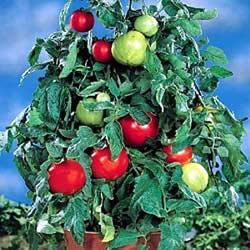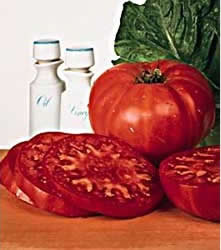If you are planning on growing your own tomatoes (Figure 1) you will find hundreds of different varieties of tomato seeds and plants. Tomatoes come in a variety of sizes, fruit weights, growing seasons, pulp densities and colors.

Figure 1 - Tomato plant
The following information should aid you in determining which tomato varieties best suit your needs and requirements.
Note: Many of the terms used to describe tomato plants are not truly defined and each grower may place a slightly different definition to a specific term. Hence, it is always wise to read the seed package and/or seedling information supplied to obtain the specific definition of any term.
Tomato Seed & Plant Terms:
- Fast Ripening: A tomato seed that will produce ripe fruit within 16 weeks of sowing the seed or within 10 weeks of planting the tomato seedling.
- Main Season: A tomato seed that will produce ripe fruit within 18 to 20 weeks of sowing the seed or within 12 to 14 weeks of planting the tomato seedling.
- Late Variety: A tomato seed that will produce ripe fruit within 22 weeks of sowing the seed or within 16 weeks of planting the tomato seedling.
- Heirloom: A Heirloom tomato seed or plant is a seed or plant that is not a hybrid - a combination of other tomato plants. Heirloom tomato seed or plants are usually more susceptible to disease and hence are harder to grow.
- Hybrid: A combination of two tomato plants that have been cross pollinated to produce a new tomato plant. Hybrid tomatoes seeds and plants are usually more disease resistant than heirloom tomato plants. Hence, they are easier to grow.
- Staking: A tomato plant that requires staking is a plant that requires some form of support to hold up its stalks and fruit during the growing season. Staking can be accomplished by placing a stake in proximity to the tomato plant and as the plant grows, tying the stalks to the stake to hold them in position. The use of tomato cages provides an acceptable method of staking tomato plants.
- Determinate: Determinate tomato plants grow as a bush, and they typically produce all their tomatoes in one batch.
- Indeterminate: An indeterminate tomato plant grows as a vine, and they’ll produce fruit all season long – until the first frost.
Primary Varieties & Types of Tomatoes:
- Beefsteak Tomatoes, as shown in Figure 2, are the biggest of the tomato varieties. There are many beefsteak tomato hybrids available. Beefsteak tomatoes are noted for their size, pulp and flavor. They are the perfect tomato for eating raw and for sandwiches. Some beefsteak tomatoes can produce fruit that exceeds 2 lbs. Most beefsteak tomato plants require staking due to the weight of the fruit. They are a popular variety for home vegetable gardens.
- Cherry Tomatoes originally received their name because they were the size of cherries. Now cherry tomatoes can be found in sizes that range from no bigger than a pea to better than 1 inch in diameter. My definition of a cherry tomato is a tomato that can be placed in your mouth hole – without the need for cutting it into pieces. Cherry tomatoes are all hybrids.
- Paste Tomatoes are a variety of tomatoes that have been hybridized so that they are an excellent fruit for rendering into a paste. They have few seeds and a solid mass of pulp. In general, paste tomatoes are not eaten raw and are used primarily for canning and sauces.
- Plum Tomatoes are one of the best all around varieties of tomatoes. They can be easily canned, used for sauces and can be eaten fresh. It is one of the most common commercially canned tomatoes. The plum tomato is generally not rounded but egg or plum shaped. There are many varieties of plum tomatoes.
- Salad Tomatoes are one of the tomato terms that have a variety of definitions, as a grower can define any tomato as being suitable for salads. However, most salad tomatoes are 1 1/2 to 2 inches in diameter. They are generally considered to be a tomato that you would serve by cutting it into halves or quarters.

